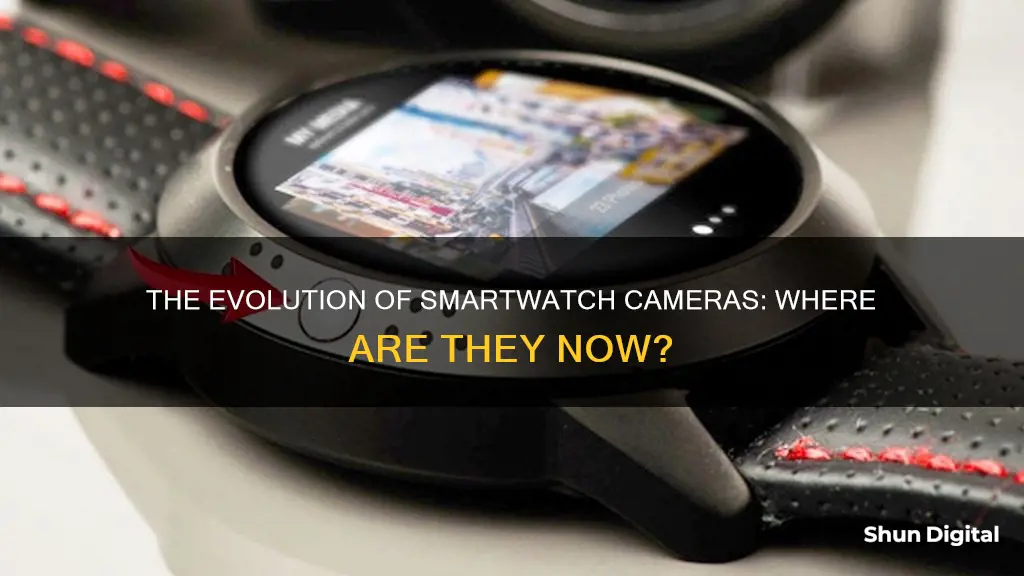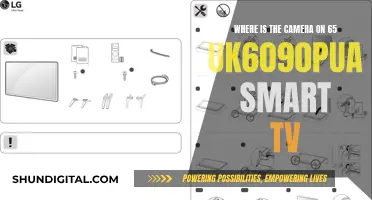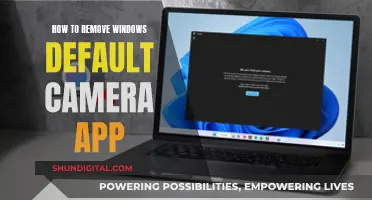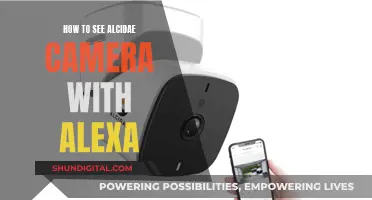
Smartwatches with cameras have been around for a while, with Samsung's first smartwatch, the Galaxy Gear, featuring a camera for taking photos directly from the wrist. However, the quality of these images was questionable, and not many mainstream smartwatch makers followed Samsung's lead. Today, most smartwatch cameras are limited to remote control of a paired smartphone's camera, with only a few third-party options offering built-in cameras.
| Characteristics | Values |
|---|---|
| Camera Quality | 0.3-8 megapixels |
| Compatibility | Android, iOS, Tizen OS |
| Connectivity | Bluetooth, Wi-Fi, USB, Cellular |
| Battery Life | 2-3 days |
| Functionality | Calls, texts, social media, fitness tracking, music controls, remote camera access |
| Design | Oversized, stylish, waterproof, etc. |
What You'll Learn

Samsung's first smartwatch, the Galaxy Gear, had a camera
The Galaxy Gear featured a 1.9-megapixel camera with a back-illuminated sensor, auto-focus, and 720p video recording capabilities. It also included a speaker, two noise-cancelling microphones, 4 GB of internal memory, 512 MB of RAM, an accelerometer, and a gyroscope. The camera app allowed users to take photos or record videos up to 15 seconds in length, which could then be stored on the device's internal storage or transferred to a paired phone or tablet.
While the camera on the Galaxy Gear received some praise for its decent quality, particularly given its low megapixel count, the watch itself received generally negative reviews from critics. One of the main criticisms was the inflexibility of the watch strap, which housed various components, making it uncomfortable to wear. Additionally, the Gear was criticised for the limited functionality of its apps and its inconsistent notification system.
Despite its shortcomings, the Galaxy Gear represented Samsung's early efforts in the smartwatch space and set the stage for subsequent iterations and improvements in the market.
Is It Safe to View an Eclipse Through a Camera?
You may want to see also

Smartwatch cameras can be used as a remote for your phone's camera
Smartwatches with cameras can be incredibly useful, but they are not very common. The first two generations of Samsung Galaxy Gear watches in the early 2010s had cameras, but they were only 2 megapixels and produced mediocre quality images.
However, smartwatches can be used as a remote for your phone's camera, which is the next best thing. This allows you to control your phone's camera shutter from your wrist, which is perfect for taking group photos or selfies without the rush of a timer. Many smartwatches, like the Apple Watch, have this feature built-in, but for others, you will need to download a third-party app. You will also need to be within Bluetooth range of your phone for this to work.
- Ensure your smartwatch is connected to your phone via Bluetooth.
- Open the camera app on your smartwatch.
- Compose your shot by using the watch as a viewfinder.
- Zoom in or out using the Digital Crown or slider on your watch.
- Tap the shutter icon on your watch to take the photo.
- Review the photo on your watch and decide if you need to take another.
- Access the settings menu to adjust flash, HDR, Live Photo, and other settings as needed.
Some smartwatches, like the Samsung Galaxy Watch 4, also allow you to record videos, switch between front and rear cameras, and set timers using the camera remote feature.
If you have a Wear OS smartwatch, you can download the Google Camera app to use as a camera remote, but this only works with Pixel phones and certain Wear OS versions. For other Wear OS watches, you may need to download a third-party app, such as Camera Remote Watch, which is compatible with various smartwatches and offers additional features like audio recording and time-lapse videos.
So, while smartwatch cameras are not prevalent, you can still use your smartwatch as a remote for your phone's camera, which provides many of the same benefits.
Amazon's Employee Surveillance: Cameras in the Workplace?
You may want to see also

Smartwatches with cameras are mostly targeted at children
Smartwatches with cameras allow children to take selfies, record videos, and store photos and video footage. Some watches, like the Apple Watch, have a built-in camera remote app, while others require a third-party app. The camera can also be used for Google Lens and other visual search features, such as object recognition for identifying plants or translation.
For parents, smartwatches with cameras can provide peace of mind by offering GPS tracking, video calling, and parent-controlled contact lists. Watches like the TickTalk 5, for example, allow parents to set reminders and timers for chores and activities, and even set do-not-disturb modes for school hours.
Overall, smartwatches with cameras can be a fun and functional way for children to stay connected with their loved ones while also offering a sense of independence and responsibility.
Apple Watch: Camera Feature or Missing Component?
You may want to see also

Smartwatches with cameras have poor battery life
Smartwatches with built-in cameras are not very common. The first two generations of Samsung Galaxy Gear watches in the early 2010s had cameras, but the quality was mediocre at around 2 megapixels. Nowadays, smartwatches with cameras are hard to come by, and it's unclear whether any models with built-in cameras are still available.
While smartwatches have evolved to become more seamless and integral to our daily lives, their battery life continues to be a significant pain point for users. The addition of a camera and other advanced features will likely exacerbate the issue of poor battery life.
The Samsung Galaxy Watch 4, for example, is claimed by Samsung to last up to 40 hours on a single charge. However, in reality, with features like GPS and activity tracking enabled, users often find themselves charging the watch daily. Apple Watches fare even worse, with a battery life of just 18 hours, and some users needing to charge twice a day if they use features like sleep tracking or long-distance running.
The inclusion of a camera on a smartwatch would likely further reduce the already limited battery life of these devices. Cameras are known to be power-hungry, and the additional processing power required for image and video capture could significantly impact the overall battery life of a smartwatch.
Additionally, there are design and aesthetic considerations that factor into the poor battery life of smartwatches with cameras. Manufacturers strive to create devices that are sleek and stylish, often marketing smaller form factors, particularly for women. This results in a trade-off between aesthetics and functionality, as a larger battery could make the device too bulky and uncomfortable for all-day wear.
In conclusion, while smartwatches with cameras may offer added convenience and functionality, they are likely to suffer from even poorer battery life than their non-camera counterparts. Until battery technology advances or more efficient power management systems are developed, smartwatches with cameras will likely continue to have subpar battery life.
Uncover Hidden Spy Cameras: Tips to Spot Them
You may want to see also

Smartwatch cameras have a low megapixel count
The first two generations of Samsung Galaxy Gear watches in the early 2010s had cameras with a resolution of around 2 megapixels, which resulted in mediocre image quality. Since then, advancements in technology have led to an increase in the megapixel count of smartwatch cameras, with some models now offering up to 5 or even 8 megapixels.
It is worth noting that the megapixel count is not the sole determinant of camera quality. Other factors such as aperture, focal length, lens quality, and sensor size also play a significant role in the overall image quality. Additionally, the intended use of the smartwatch camera should be considered. For casual photo-taking or quick social media stories, a lower megapixel count may suffice. However, for professional-looking photos or detailed content, a higher megapixel count or a dedicated camera would be more suitable.
When shopping for a smartwatch with a camera, it is important to consider not only the megapixel count but also other features such as compatibility with your smartphone's operating system, durability, functionality, battery life, ease of use, and design. Additionally, privacy and bulkiness concerns have led major brands like Apple and Samsung to forgo including cameras in their smartwatches, leaving consumers to explore alternative options from third-party manufacturers.
Camhi Cameras: Viewing on PC
You may want to see also
Frequently asked questions
Some of the best smartwatches with cameras include the Refly 4G Smartwatch, the Zeblaze Thor 4, the Maksnuts Nubia Alpha Smartwatch, and the Wristcam for the Apple Watch.
The Wristcam is the first Apple-certified smart band with a built-in camera. It features world-facing (8-megapixel) and self-facing (2-megapixel) lenses that can be controlled with the band's manual controls or the watchOS app.
Smartwatch cameras tend to have low battery life and limited functionality, especially for Apple devices. The cameras often have low megapixel counts, ranging from 0.3 to 2 megapixels, and the images and videos produced are typically of mediocre quality.
Smartwatch cameras allow for convenient photo and video capture, especially during activities when it is difficult to access a smartphone, such as walking a dog or playing sports. They can also be used as a remote for a smartphone's camera, enabling easier group photos and selfies.







